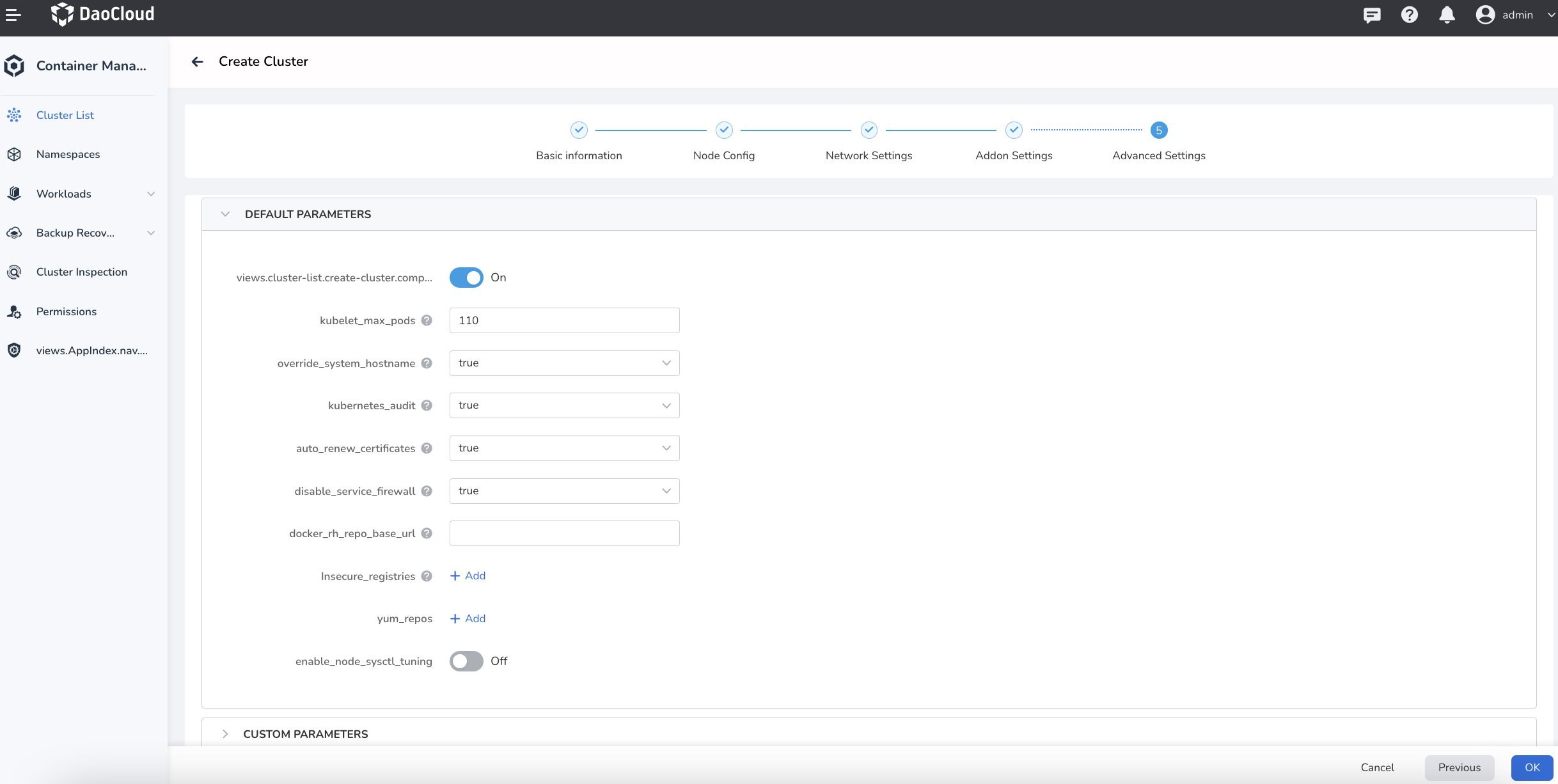Installation parameter configuration¶
This page describes the configuration of various parameters when installing Cilium with Kubean, as well as the enablement of the main features and related instructions.
Prerequisites¶
-
Make sure the OS Kernel version number >= 4.9.17, 5.10+ is recommended.
-
To install Cilium in DCE 5.0, you need to select
ciliumforNetwork Pluginson theCreate Cluster->Network Configurationpage. For creating a cluster, see create worker cluster.

Parameter configuration¶
If you need to configure more features for Cilium, you can install Cilium via Kubean. Add and fill in parameters as needed under Advanced Configuration->Custom argentums when installing Cilium using Kubean.

The following describes the configuration of each argument when installing Cilium with Kubean:
-
Cilium data schema
By default, the VXLAN tunnel mode is used, which is set by the following parameters:
Supported values are "vxlan", "geneve" and "disabled", where "disabled" means use route mode.
-
IPAM mode
IPAM is responsible for assigning and managing the IP addresses of network endpoints (containers or otherwise). Cilium supports several IPAM modes. By default, the "Cluster Scope" mode is used, which can be set with the following parameters:
Supported values include "cluster-pool", "kubernetes" and modes customized by major public clouds.
-
kubernetes: uses the host-scope IPAM that comes with Kubernetes. Address assignment is delegated to each node and the Pod CIDR for the per-node is stored in v1. -
cluster-pool: the defaultIPAMmode, which allocates the Pod CIDRs of theper-nodeand uses thehost-scopeallocator on each node to assign IP addresses.
This mode is similar to kubernetes, with the difference that the latter stores the Pod CIDR of the per-node in the v1.Node resource.
-
-
IPV4 and IPV6
By default, IPV4 is used, which can be set by the following parameters. If dual stack is enabled through the interface, the default IPv6 parameters are automatically turned on:
-
Cluster name
The default Cilium cluster name is "default", which can be set by the following parameters:
-
Identity mode
For the cilium id storage structure like
crdorkvstore, it is usually a more convenient choice for storing meta information directly using CRD. But in large clusters, it is more efficient to split a separate set of ETCDs for cilium to use alone.The "crd" mode is used by default, which can be set by the following parameters:
-
Resource Limits
The default values are:
cilium_memory_limit: 500M cilium_cpu_limit: 500m cilium_memory_requests: 64M cilium_cpu_requests: 100mUsers can make corresponding adjustments according to their own cluster conditions.
-
Time for Cilium DaemonSet to be ready again
It can be set by the following parameters:
-
Monitor aggregation level
By default, "medium" is used, which can be set by the following parameters:
Supported values are "none", "low", "medium", and "maximum".
Generate a monitor notification when TCP which flags are monitored for the first time. And only takes effect when the aggregation level is "medium" or higher.
It can be set by the following parameters:
-
Replace kube-proxy
By default, no replacement is performed, and it can be turned on or off on the interface, or set through the following parameters:
Supported values are "disabled", "strict", "probe", and "partial".
-
Whether to do SNAT when traffic leaves the cluster
Cilium by default does SNAT on IPv4 and IPv6 (if enabled) traffic leaving the cluster. It can be set by the following parameters:
The way to do SNAT uses "iptables" by default, and also supports "eBPF" mode, which is more efficient, but "eBPF" does not support IPv6.
Can be set via the following parameters:
-
Hubble
Hubble is installed and enabled by default, and how to enable Hubble metrics. The metrics exposed by default are:
It can be set through the following related parameters:
-
Automatic mount of cgroup2 file system
By default, the automatic mounting feature of the cgroup2 file system is enabled, and the default mounting path is "/run/cilium/cgroupv2".
It can be set by the following parameters:
-
Bypass netfilter in the host namespace
By default, netfilter in the host namespace is bypassed, which can be set by the following parameters:
-
Enable remote node identity
Remote node identity is enabled by default and can be set with the following parameters:
-
Custom parameters
Kubespray supports limited Cilium parameters. If you want to enable configurations that Kubespray does not support, you can set them through the following parameters:
-
Kubespray supported parameters
Kubean calls Kubespray by default to install the cluster, see the following documentation: